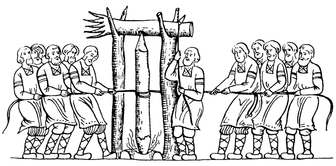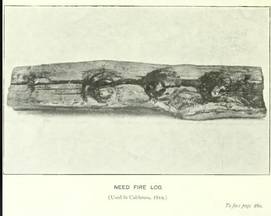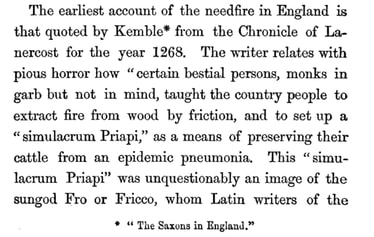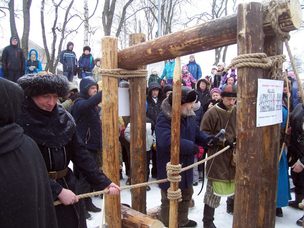European Fire Rituals - Neid Fire
Last updated 28-Sep-23 - I hope to further add to this section
 A Russian illustration of the Fire Gate being used to kindle Sacred Living Fire - image appears in the book We Are Slavs by Maria Semyonova (click on image for online copy of book)
A Russian illustration of the Fire Gate being used to kindle Sacred Living Fire - image appears in the book We Are Slavs by Maria Semyonova (click on image for online copy of book)
Neid Fire, Need Fire, Neid Fyre, Force Fire, Teine-éiginn, Tein'-éigin, Tein eigin, Notfeuer, Nodfyr, Nedfres, Nedfri, священного живого Огня
Overview
The Neid Fire ritual has mostly been erased from our ancestral memory in the UK. My passion is for Neid Fire to become part of our heritage once again!
This page gives an overview of the ritual practice.
I also have a section on the Fire Churn apparatus and my research,
I am fascinated by the old mostly long forgotten ritual practice of Live Fire, Emergency Fire, Wild Fire, Neid Fire, Force Fire, Tein'-éigin, Notfeuer, Nodfyr, Nedfris, Nedfres, священного живого Огня (Sacred Living Fire). I am also fascinated by the friction fire contraptions described by many 19th and 18th century writers used during these rituals which I will refer to as Fire Churns - which are different the Vedic Fire Churning practice. These rituals took place throughout Scotland, England, Europe and Russia
until approx the 1850s to kindle a new pure fire. A new pure fire would be kindled either at times of distress (e.g. outbreak of disease amongst cattle or people) or at auspicious times of the year e.g. Beltaine or Samhain.
My fascination isn’t just on the practical level but also the symbolism and spiritualism of these rituals and the communal extinguishing and relighting of hearth fires; and the importance of the community coming together at times of distress and at auspicious times of the year (I may explore this further in a blog post at some point.) The practicalities I explore here is just one aspect.
The Neid Fire ritual has mostly been erased from our ancestral memory in the UK. My passion is for Neid Fire to become part of our heritage once again!
This page gives an overview of the ritual practice.
I also have a section on the Fire Churn apparatus and my research,
I am fascinated by the old mostly long forgotten ritual practice of Live Fire, Emergency Fire, Wild Fire, Neid Fire, Force Fire, Tein'-éigin, Notfeuer, Nodfyr, Nedfris, Nedfres, священного живого Огня (Sacred Living Fire). I am also fascinated by the friction fire contraptions described by many 19th and 18th century writers used during these rituals which I will refer to as Fire Churns - which are different the Vedic Fire Churning practice. These rituals took place throughout Scotland, England, Europe and Russia
until approx the 1850s to kindle a new pure fire. A new pure fire would be kindled either at times of distress (e.g. outbreak of disease amongst cattle or people) or at auspicious times of the year e.g. Beltaine or Samhain.
My fascination isn’t just on the practical level but also the symbolism and spiritualism of these rituals and the communal extinguishing and relighting of hearth fires; and the importance of the community coming together at times of distress and at auspicious times of the year (I may explore this further in a blog post at some point.) The practicalities I explore here is just one aspect.
|
The tradition of these fires apparently may date (there is no proof, only speculation) back to approximately the age of the Celts & Slavs \ Iron Age (somewhere from 600BC onwards ) throughout Europe\Russia . It does seem that they were in use during the Middle Ages as apparently there is historical evidence in the 7th and 8th centuries that attempts were made to ban the Neid Fire practices by the Church (see further below) I have found various written accounts by various writers from the 17th century onwards : Johannes Reiske (German educator and historian 1641 - 1701) wrote Not Feuer in 1696; Sir James Frazer (Anthropologist 1854 to 1941 author of "The Golden Bough" ) describes the Fire rituals of Europe and Fire Churns; Martin Martin (Màrtainn Màrtainn dod 1718 author of A Description of the Western Islands of Scotland 1703); Alexander Carmichael (folklorist 1832-1912 author of Carmina Gadelica, a compendium of Highland lore and literature .); Curiosities of Indo-European Tradition and Folk-lore by Walter Keating Kelly 1863.
There is also evidence of Fire Gates in Russia where they are called огненные ворота (Fire Gate) and are still used today. Based on the various writingsand references, it does seem that it was indeed a practice but there is no way of knowing how far back it dates. |
|

This photograph, from The Folklore journal published in 1898, is supposed to show a piece of wood used in one of the last Neid Fire (or Teine Eigin ) rituals that took place in Houstry in the Highlands of Scotland in 1810. This "artifact" was kept in the family of Rev. George Sutherland, of the Free Church of Scotland, Torosay, Isle of Mull. This is the first time I've ever come across any sort of archeological\photographic evidence (apart from written accounts) of the practice of Teine Eigin (Neid Fire.). Of course, this is no absolute evidence, it could be just a piece of wood :) It looks to have burnt holes but no notches, so very intriguing all the same . And if indeed it was kept in the family for over 80 years, then it must have been a very special piece of wood.
Go to the below link for the full article, including an account (presumably passed down the family) from Mr Sutherland of the last Teigne Eigin in Mull (I find this absolutely fascinating and I have located the Burn (stream) of Houstry mentioned where the ritual took place on an island. ) Joustry is one place I would love to visit!
https://en.wikisource.org/wiki/Page:Folk-lore_-_A_Quarterly_Review._Volume_9,_1898.djvu/306
Go to the below link for the full article, including an account (presumably passed down the family) from Mr Sutherland of the last Teigne Eigin in Mull (I find this absolutely fascinating and I have located the Burn (stream) of Houstry mentioned where the ritual took place on an island. ) Joustry is one place I would love to visit!
https://en.wikisource.org/wiki/Page:Folk-lore_-_A_Quarterly_Review._Volume_9,_1898.djvu/306

I've recently discovered "Curiosities of Indo-European Tradition and Folk-lore "by Walter Keating Kelly 1863
Chapter II is very interesting as it talks about Sacred Fire, Fire Churning (in India and Europe) and Neid Fires.
I've found a free on-line version here.
Chapter II can be found from page 37 onwards. It's interesting as Walter talks alot about other contraptions being used to produce the fire such as cart wheels and horizontal fire churns - as well as the fire churn's I've pictured on this page.
The extract to the left is also intriguing as it states that the earliest account of the Neid fire in England is from 1268 documented in the Chronicle of Lanercost. There is an ebook of the Lanercost Chronicles here but it's mostly in latin and I've not found a translation for the year 1268, so currently I can only go on Walter Kelly's assumption.
Chapter II is very interesting as it talks about Sacred Fire, Fire Churning (in India and Europe) and Neid Fires.
I've found a free on-line version here.
Chapter II can be found from page 37 onwards. It's interesting as Walter talks alot about other contraptions being used to produce the fire such as cart wheels and horizontal fire churns - as well as the fire churn's I've pictured on this page.
The extract to the left is also intriguing as it states that the earliest account of the Neid fire in England is from 1268 documented in the Chronicle of Lanercost. There is an ebook of the Lanercost Chronicles here but it's mostly in latin and I've not found a translation for the year 1268, so currently I can only go on Walter Kelly's assumption.
To me, it seems that the Neid Fire practices may have been the only time friction fire was used in Europe at that time as from the Iron Age onwards flint and steel seems to have been the main method. These Fire Churns were mainly used in times of distress or at auspicious times of the year (such as the Celtic festivals of Beltaine and Samhain and Slavic Ivan Kupala festival ) to kindle a new pure fire which has been referred as Live Fire, Neid Fire, Force Fire, Tein'-éigin, Notfeuer, Nodfyr, священного живого Огня (Sacred Living Fire.)
In all instances (and it seems cultures) of kindling the new pure fire using the Fire Churn, all fires within the local community would be extinguished . Once the new fire had been kindled and offerings made, then everyone in the community would light their fires from the new communal fire. In the case of curing ills, damp wood would be added to make copius amounts of smoke and the cattle\people would be paraded through the smoke to "cleanse" them. or in other accounts water is boiled on the fire and then sprinkled over the people\animales. The community would also take a brand from the fire and re-light their hearth fires after the ceremony. It seems different communities would have slightly different rituals, requiring a certain amount of people involved in making the fire, or the fire having to be made in a particular way depending on local beliefs and superstitions e.g. 9 times 9 first begotten sons.
In all instances (and it seems cultures) of kindling the new pure fire using the Fire Churn, all fires within the local community would be extinguished . Once the new fire had been kindled and offerings made, then everyone in the community would light their fires from the new communal fire. In the case of curing ills, damp wood would be added to make copius amounts of smoke and the cattle\people would be paraded through the smoke to "cleanse" them. or in other accounts water is boiled on the fire and then sprinkled over the people\animales. The community would also take a brand from the fire and re-light their hearth fires after the ceremony. It seems different communities would have slightly different rituals, requiring a certain amount of people involved in making the fire, or the fire having to be made in a particular way depending on local beliefs and superstitions e.g. 9 times 9 first begotten sons.

It seems this tradition occurred as recent as until the early to mid 1800s in the highlands of Scotland, and the Fire Gates are still very much used in Russia. In the city of Vologda in Feb 2017, the city administration organised lighting of the Sacred Living Fire "священного живого Огня" using the Fire Gate - see photo to the left and click on photo for the Russian article.
It seems the disappearance of the Fire Churns throughout Europe was largely due to the church apparently banning the Neid fires as they were seen as heathen: "The history of the need-fire can be traced back to early Middle Ages; for in the reign of Pippin, King of Franks, the practice of kindling need-fires was denounced as a heathen superstition by a synod of prelates and nobles held under the presidency of Boniface, Archbishop of Mainz.689 Not long afterwards the custom was again forbidden, along with many more relics of expiring paganism, in an "Index of Superstitions and Heathenish Observances," which has been usually referred to the year 743 A.D., though some scholars assign it a later date under the reign of Charlemagne" (from The Golden Bough by Sir James Fraser. Though, I've not yet been able to substantiate this and can only find this referenced by Sir James Fraser.)
12-Oct-18 - update: Henry Cowper references the banning of the Nedfri in 742 by the Synodus Francisca in his book "Hawkshead (the northenmost parish of Lancashire)" 1899 (see further below) which is very interesting.
In "Primitive beliefs in the north-east of Scotland" by J.M. McPherson (1875) , McPherson writes of various cases of Neid Fires being dealt with by the Church, including this one "Strathbogie was notorious for it's practice of this heathenish custom, and the Synod of Moray, in 1649, adopted a general rule to be applied to all offenders there - raisers of Neid fire in the Presbytery of Strathbogie were ordained to satisfy 3 days in sackcloth" (pg 30)
It is also interesting to note that the Church turned the "pagan" fire festivals into Christian festivals such as St John's fires (Easter fires) - e.g. the Slavic Ivan Kupala festival is now celebrated as the Feast of St John the Baptist.
12-Oct-18 - update: Henry Cowper references the banning of the Nedfri in 742 by the Synodus Francisca in his book "Hawkshead (the northenmost parish of Lancashire)" 1899 (see further below) which is very interesting.
In "Primitive beliefs in the north-east of Scotland" by J.M. McPherson (1875) , McPherson writes of various cases of Neid Fires being dealt with by the Church, including this one "Strathbogie was notorious for it's practice of this heathenish custom, and the Synod of Moray, in 1649, adopted a general rule to be applied to all offenders there - raisers of Neid fire in the Presbytery of Strathbogie were ordained to satisfy 3 days in sackcloth" (pg 30)
It is also interesting to note that the Church turned the "pagan" fire festivals into Christian festivals such as St John's fires (Easter fires) - e.g. the Slavic Ivan Kupala festival is now celebrated as the Feast of St John the Baptist.
History and Folklore
I will add to this section over time as I discover new references to the history and folklore of these devices. At the moment, this page is a bit scrappy and more of a collection of references for me to follow up on.
In Europe it seems the use of these devices and ritual kindling of the Neid Fires and kindling of seasonal fires using these churns (e.g. Beltaine fires) disappeared in the early to mid 19th century:
I will add to this section over time as I discover new references to the history and folklore of these devices. At the moment, this page is a bit scrappy and more of a collection of references for me to follow up on.
In Europe it seems the use of these devices and ritual kindling of the Neid Fires and kindling of seasonal fires using these churns (e.g. Beltaine fires) disappeared in the early to mid 19th century:
- One of the last known use of the Fire Churns was n Helmsdale (Scotland) in 1818 until a Fire Churn was reconstructed by Tim Knowles as part of an art installation at the Helmsdale Highland Games in 2015 (see more info here.)
- The Beltane (then later Samhain) Fire Festival was re-established in Edinburgh in 1988 which saw the estabishment of the Beltane Fire Society who organise the Beltane and Samhaain Fire Festivals in Edinburgh. They light the starting "Neid fire" with the bow drill, all other torches and fires are lit from this new fire.
- In Ireland there is the Samhain Fire Festival which takes place at Tlachtga on 31st October. Some think Samhain originated at Tlachtga (Hill of Ward) more than 2,000 years ago.
- In Russia , the fire churns still seem to be used and I have come across quite a few photos and articles of re-enactments.